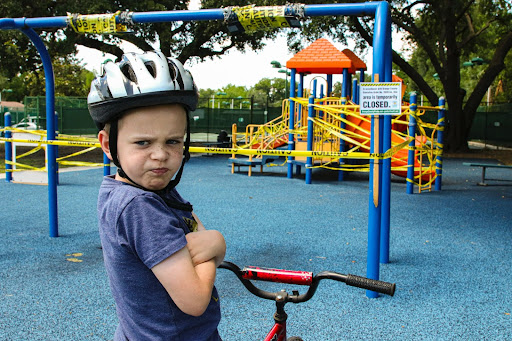Blending a family while nurturing new sibling relationships, isn’t a simple task.
It requires you to be thoughtful of each child and remember the separate, and long-established, histories they each bring with them.
Let’s dive right in!
Tips For Blended Families To Deal With Step Sibling Rivalry And Bullying
1. Set Expectations Of Behavior
Sit down with your partner and agree on the standards of behavior you’d like to set for all members in your household.
Expectations such as:
- No physically hurting each other
- Be willing to share communal items such as the TV
- Share time with each parent
Then decide how you’ll respond to broken standards:
- Taking away phone or TV privileges
- Staying in for the weekend
- Sharing their portion of dessert with everyone at the table
- Taking care of the family pet or an elderly family member or neighbor for a week
Be consistent and fair in applying these rules to everyone. Once you agree on how to
move forward, communicate that with love.
2. You’re The Role Model
Start by remembering you’re their role model. Young people pick up a lot just from observing you and your partner, so set a good example.
Talk to them and each other with respect and kindness, even when things are tense. Let them see you handling conflicts with grace and a strong sense of fairness.
Show them how to listen and be considerate, by listening and being considerate with them and your partner.
3. Encourage Your Teens
If you have tween or teens in the household, try to get them on board with being a role model for the younger ones.
Older ones can make wonderful role models, and your little ones are even more likely to copy their siblings than their parents.
4. Teach About Sharing And Respect
A lack of respect can morph into hate for each other. Teaching siblings to share nicely is vital, but teaching respect for each other’s possessions is just as important.
Teach step siblings respect for each other’s possessions by showing them through your actions. Also remember, kindness changes everything.
5. Privacy Is Part Of Respect
Older children in blended families feel like their space and privacy is being taken away from them, especially if they’ve inherited younger siblings who want to follow them around!
Speak with them openly and work together to support their requirement for privacy. This will save stress, anger and resentment. Some ideas are:
- Some time outside
- A trip to the park or mall with their biological parent
- A section of the house for privacy
6. Time For Bonding
Make sure you allow for family time when they can bond with each other and with you.
For example:
- Set aside a regular family mealtime when everyone can sit down around the table and talk about what happened for them that day.
- Designate a weekly beach day.
- Set up a family game night.
By setting aside time for fun activities you reinforce the idea that step siblings can be fun new playmates and someone to make happy memories with.

7. Let It Happen Naturally
Trying to force step siblings to get along is bound to backfire. Encourage time together while allowing everyone their own space, too.
Your kids and stepkids might be able to learn to be civil and spend a little time together and if they don’t become the best of friends, that’s ok.
Let the relationships develop naturally without being attached to the idea of your kids being best friends. A respectful truce is much more realistic.
8. Let Go Of Labels
By labeling our children, we unintentionally shelve kids into one role or another and create comparisons between them.
When you talk about your “athletic one,” “the good eater,” “smartie,” or even your “wild child,” you inadvertently draw comparisons between your kids.
By referring to one child as the “athletic one” the other one automatically thinks “I’m not the athletic one” (so why even try) or when one child is a “good eater” the other assumes she must not be.
Cheer on positive attributes of all the children. Siblings can then root for each other instead of competing for their parents’ approval.
9. Attention Seeking
To satisfy your kids’ need for attention, plan on giving each child at least 10-15 minutes of kid-centered one on one, intentional attention every day.
It will have incredible effects on the health of your child’s mind, body, and soul.
Kid-centered means your young one calls the shots for 10-15 minutes. Fun things within reason, like:
- A tea party
- Lego building
- Dressing up daddy
- Sidewalk drawing with chalk
- Listening to their favorite music with your teen
- Shooting some hoops
Be fully present. Put down your phone, don’t answer that email, turn off the show you’re watching. Let your child know how much you enjoyed the time together.
10. Time For Peace
Sending kids to separate corners for time out might give them space to calm down, however, it won’t teach them how to resolve conflicts.
Here are some ideas for how you can role play to help build conflict resolution skills:
- Communication: Give siblings respectful words to use, “May I please play with…” and language for responding, “I’m not quite finished playing with it, but I’ll let you know when I’m done.”
- Languaging: Feelings are normal and there are appropriate ways to express them. Teach them the language to use when feeling frustrated, “I feel mad when Sam doesn’t let me play with the car” or “I feel hurt when Alison hits me…”
- Tempers:Teach kids these coping skills to diffuse a situation until they’re ready to talk:
• walk away
• count to 10
• deep breaths, etc.
11. Let The Squabbles Fizzle Out
This might surprise you, but the best thing you can do when a disagreement starts to brew is – ignore it.
That’s right, find something else to do in another room. This way, you don’t reward argumentative behavior with your energy and attention. Most importantly, you give them a chance to work it out on their own.
12. Stepping In To Calm The Conflict
If a conflict has escalated and you decide to step it, whatever you do, don’t take sides. You might think you heard or saw what started the argument, yet, until both sides have had a chance to say their piece, don’t place judgment on either party.
Once everyone is calm, listen to each child’s version of what happened while encouraging them to use “I feel” statements.
Then, without placing blame or taking sides, ask them to come up with some solutions. If no one is able to come up with a workable resolution, suggest a few yourself, and help them reach an agreement.
Related: When To Leave Because Of Stepchild: 12 Clear Signs & Tips
13. All Sides Being Equal
If, after hearing both sides and attempting to find a solution, your kids still can’t agree, it’s time that everyone involved in the argument experiences the same outcome or consequence.
You could say: “Either you can take turns with the game, or I’ll put it away for the rest of the day.” And follow through.
After some complaining and negotiating, your kids will quickly realize it’s in their best interest to agree on a solution before you take the whole thing away.
The primary focus is for stepparents to build a bond rather than disciplining the children initially. Without a healthy relationship, discipline won’t work.
If you both have children already, there’s a good chance you have different rules. It’s important to come together to create the same rules for everyone so you don’t live like two separate families under one roof.
Having one parent as the “fun one” , while the other does all the discipline tells the master manipulators who the “easy target” is.
Work together as a team by explaining that, in your house, both adults can enforce consequences to any of the children, and it’s expected they will obey the stepparent as they would any other authority figure.
15. Do You Love Me?
Everyone needs reassurance that they are loved for who they are. When children experience a break in their primary relationships their need for reassurance goes up.
Add in a new partner and new siblings and it becomes vital that both sets of children feel they matter to you.
Offering special time to your step children helps you get to know each other better, allows for important bonding, and lets them know you hold them on equal footing with your biological children.
16. Your Big Feelings
Our parents most likely lacked support for their parenting, and were too often short on patience. So if we fought with our siblings, we learned to threaten, yell at, bribe, lecture, or punish in some way.
Acknowledging your own feelings, then learning to release and step back from pent up emotions so they don’t impact others, is an emotional skill that benefits everyone.
Build more support for yourself in your parenting journey to increase your patience and work toward blending your families together thoughtfully and creatively so each person can thrive in your new family structure.
17. Challenges Of Adjustment
It can be really hard on some kids when suddenly they have these new siblings whom they don’t really know, and they’re not even sure they like.
Be honest with every family member that blending families can be tricky. So there will inevitably be some bumps and hurt feelings along the way which you’ll all help support each other through.
18. Acknowledge The Truth
Kids are smarter than adults often give them credit for. If you immediately insist that you’re as close to your new step children as you are to your own, it’s probably going to cause a few eye rolls.
It might even cause some hurt feelings. Be honest about your own feelings, and acknowledge that it’s perfectly normal for biological parents to be closer to their own kids, at least at first.
19. Birth Order
In merging two families with more than one child who are accustomed to holding certain ranks by birth order, suddenly, your oldest child may no longer have that position in the family.
The baby of one family may find themselves in the unfamiliar and possibly even uncomfortable role of an older sibling.
It’s important to be aware of these shifts and how they make children feel unsettled and maybe even resentful.
20. Regular Family Meetings
It might be monthly, or even weekly. Set aside a time for your family to gather and share opinions without judgment.
Encourage everyone to really listen to each other. This may give everyone a chance to see and be seen and hear and be heard.
21. Ask Kids For Suggestions
Kids often feel like no one is listening to them. So, show them you want to hear from them.
Ask for their opinions and suggestions for how to improve certain situations. This gives each child the chance to be heard and the chance to make recommendations about how to improve relationships.
Why Do Step Siblings Hate Each Other?
There are a number of potential causes for why stepsibling rivalry. Here are some primary factors:
- The stress of blending two families with their varying personalities
- Unresolved feelings of hurt from the breakup of their other family unit
- Jealousy when their parent treats their stepsibling with love or care
- Jealousy when one child feels slighted
- Insecurities about their own role in this newly blended family
Each child is different and will have different reactions.
No one wants to feel like they don’t matter. Acknowledge there will be vulnerable feelings. Then go out of your way to celebrate the unique characteristics of each child.
How Do You Deal With Step Siblings Not Getting Along?
Despite all the love you give, it may be difficult for step siblings to get along. However, here are some steps towards finding peace.

1. Establish Expectations
This can be done by:
- Having family meetings where all attend.
- Asking each child ahead of time what they expect from the family.
- Facilitate dialogue with everyone in the family and post ideas.
- Create a list of norms that everyone can agree on. Sign it and post it prominently.
By involving your step children in the planning process they’ll be more engaged and invested in the outcome.
2. Find Ways For All The Step-Children To Get Know Each Other
Just like any new relationship, the step siblings require the chance to get to know each other.
Consider:
- Game night: Play board games or put puzzles together one night a week. Games where they work together to solve problems are a good idea.
- Attend an event: Take the kids to an athletic event, concert, or the movies together. Anything that allows them to spend time together.
- Outdoor recreation: Play a pickup game of basketball, go for a hike, or visit the beach. Maybe each child has a favorite spot they like to go to and could share with their step-siblings.
- Cooking: Have them participate in cooking a meal together.
3. Be Patient
Change in general can be difficult. Remember they’re trying to figure out this new situation too. Let them try to figure it out themselves before you step in. This can help prevent you from getting drawn into an argument.
4. Have A Private Space For Each Of The Children
It might be a good idea for all of the siblings to have some space from each other to be able to calm down.
Having their own room is nice, but that may not always be practical. Some ideas include:
- A large closet or storage area that can be converted into a personal space.
- The corner of a room that is off limits to everyone else.
- Anything that allows the child to say that this is their space.
5. Resolve Conflicts
Whatever the disagreement, don’t let it slide under the rug and be forgotten until the next blow-up. Make it a priority the conflict is resolved between them.
Otherwise, resentment could fester until another disagreement blows up which could get worse as time goes on.
6. Remember The Benefits of Being Together
When stress gets to the boiling point, remember the love you have for your partner and his or her own children.
Remember how both of you want to be together and share life as a family unit. Also, don’t forget to keep in mind the positive benefits of being a family.
Related: When To Leave A Blended Family
What Is The Root Cause Of Sibling Rivalry?
Some experts say sibling rivalry stems from children competing for their parents’ love. Others say the goal is parental recognition or attention. It can start even before the second child comes into the picture.
Siblings may be jealous of and harbor resentment toward one another. The main causes of are:
- Lack of social skills
- Concerns with fairness
- Individual temperaments
- Special needs
- Parenting style
- Parent’s conflict resolution skills and culture.
Who Should Come First In A Blended Family?
In blended families, without a committed partnership there is no family at all. The couple is the sole focus that ties the two families together into one.
If that relationship falls apart, the entire family unit will separate as there is nothing that ties them together but the couple.
The key to moving the kids into the backseat, literally and figuratively in blended families, is to make your couple relationship the #1 priority in your stepfamily.
The couple must be united and committed to one another in such a way that the children learn they cannot come between them or manipulate them because both biological and stepparent are on the same page when it comes to rules, discipline, rewards, consequences, etc.
What Is Sibling Rivalry Definition
Sibling rivalry describes the ongoing conflict between kids raised in the same family. It can happen between biological siblings, step siblings, and even adopted or foster siblings.
It might take the form of:
- Verbal or physical fighting
- Name calling
- Tattling and bickering
- Being in constant competition for parental attention
- Voicing feelings of envy
It’s stressful for mom or dad, however it’s common and totally normal.
Explain Sibling Rivalry
This is the jealousy, competition and fighting between brothers and sisters. It’s a concern for many parents of two or more kids and the problems often start for an only child right after the birth of the second child.
This usually continues throughout childhood and can be very frustrating and stressful to parents.
Fortunately, your kids will most likely have a relationship that will eventually develop into a close one and they’ll get along well.
Working things out with siblings gives them a chance to develop important skills like cooperating and being able to see another person’s point of view.
Types Of Sibling Rivalry
Other factors, besides jealousy or competition, might influence how often kids fight and how severe the fighting gets. These include:
- Evolving Needs
It’s natural for kids’ changing needs, anxieties, and identities to affect how they relate to one another.
For example:
- Toddlers are naturally protective of their toys and belongings, and are learning to assert their will, which they’ll do at every turn.
- School-age kids often have a strong concept of fairness and equality, so might not understand why siblings of other ages are treated differently or feel like one sibling gets preferential treatment.
- Teenagers are developing individuality and independence, and might resent helping with household responsibilities, taking care of younger siblings, or even having to spend time together.
- Individual Temperaments
Your kids’ mood, disposition, adaptability, and their unique personalities play a large role in how well they get along.
- Special Needs Or Sick Kids
Sometimes, a child’s special needs due to illness, learning or emotional issues may require more parental time. Other kids may pick up on this disparity and act out to get attention or out of fear of what’s happening to the other child.
- Role Models
If you and your spouse work through conflicts respectfully, productively, and not aggressively, you increase the chances that your children will adopt those tactics when they run into problems with one another.
Related: Toxic Family Members Quotes
Sibling Rivalry Is Often Exacerbated In A Stepfamily
There are three key issues to consider as you plan for remarriage and having your families merge together in the same house:
- Financial And Living Arrangements
Most often partners entering a second marriage report that moving into a new home, rather than one of the partner’s prior residences, is preferred because the new environment becomes “their home.”
Couples who have used the “one-pot” method for finances generally reported higher family satisfaction than those who kept their money separate.
- Resolving Feelings And Concerns About The Previous Marriage
Remarriage may resurrect old, unresolved feelings from the previous marriage, for all family members.
For example, hearing that her parent is remarrying, a child is forced to give up hope that the custodial parents will reconcile.
- Anticipating Parenting Changes And Decisions
Even if the couple lived together before marriage, the children are likely to respond to the stepparent differently after remarriage because the stepparent has now assumed an official parental role.
So it’s important to be a united partnership regarding roles and expectations.
What Is Normal Sibling Rivalry?
Sibling rivalry is a predictable, normal and healthy response to the birth of a younger sister or brother.
In most families it demonstrates that the older child is appropriately attached to the parents and is responsive to a perceived threat to their relationship.

Sibling fights, name calling, tattling and bickering are all normal forms of sibling rivalry.
It’s a normal response to having your place as the baby of the family usurped. In this context, sibling rivalry can be viewed positively.
Its absence could be worrisome. Sibling rivalry is not a disease, but a manifestation of psychological health.
It can seem difficult for half siblings to get along with each other at first, let alone those who are part of a blended family.
However, by finding ways to problem-solve with patience, steps can be taken to have a healthy relationship with each other.
If you found this article helpful ✅, please send it to your friends struggling with a blended family situation so they can benefit too.
